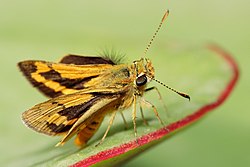| Ocybadistes | |
|---|---|
 | |
| Ocybadistes walkeri | |
| Scientific classification | |
| Kingdom: | Animalia |
| Phylum: | Arthropoda |
| Class: | Insecta |
| Order: | Lepidoptera |
| Family: | Hesperiidae |
| Tribe: | Taractrocerini |
| Genus: | Ocybadistes Heron, 1894 |
Ocybadistes is a genus of skippers in the family Hesperiidae.